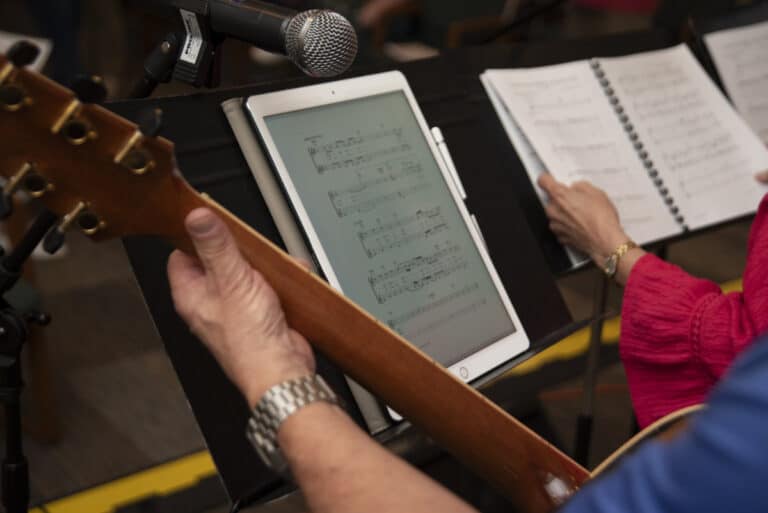A capo is a valuable tool that any guitarist should have in their music bag. When clamped across the strings of a guitar at a chosen fret, a capo raises the pitch of the strings. Many guitarists have used a capo and played the written capo chords in their music, but they may not have thought much about what’s happening and why when they use a capo. Other guitars may have experience using capos to transpose keys and modify chord shapes already.
There are two main reasons a guitarist may use a capo: to change the key of a song (if the same chord shapes are played) or to keep the song in the same key but use a different set of chord shapes. This article demonstrates the process of figuring out where to place the capo for each reason, including explaining the thought behind it, providing some convenient tables for easy reference, and offering some examples with actual songs.
The basics: How capos work
The shorter a string gets, the higher its pitch gets. When a player frets a note on the fretboard, the vibrating section of the string gets shorter. For example, a string fretted at the fifth fret is shorter than one fretted at the third fret — and it sounds higher as a result. The capo takes the place of a finger and frets across all the strings at once, like when you make a barre chord. (By the way, in this article it’s assumed that we’ll use only one capo and no “partial” or “cut” capos. That’s a topic for another time!)
Scenario 1: Using a capo to transpose keys
For the first case of capo use, changing a song’s key, refer to Table 1 below. Since each fret represents an interval of a half step on a string, capoing up a fret (going from no capo to a capo at the first fret, for example) raises the song’s key by one half step. An example of a half step would be going from E to F, B to C, or G to Ab (or G#). There are two half steps in one whole step, so that would be the same as moving the capo up two frets. An example of going up a whole step is moving from G to A or from C to D. Table 1 simply lays out the possible key root notes in order of half steps. It doesn’t matter if the key is major or minor. For example, if your original key is in the key of Em, capo at the fifth fret to change that to Am.
Let’s say you’ve prepared to play Marty Haugen’s “Canticle of the Sun,” which is in the key of G in hymnals today. However, when you arrive at choir practice you discover that your director has planned to sing it in A. What do you do? You can either transpose (change) each chord up a whole step, or you can simply put your capo on the second fret. Look at Table 1 below and see Step 1. Follow that column down until you arrive at G, the original key. Now follow Step 2: Go to the new key, A, and follow it down until you arrive at where the row for G intersects it. The number 2 there tells you that you would put your capo on the second fret.
For another example, you may have a nice fingerstyle version of “Silent Night” worked out in the key of G. However, if you’re playing it on Christmas Eve, you may find yourself accompanying a choir in either the key of A (especially if sung with “Night of Silence”) or in Bb (if sung by itself). Table 1 will tell you that you should capo at the third fret for Bb and the second fret for A. This way it will sound fine without having to relearn a new arrangement of the song.
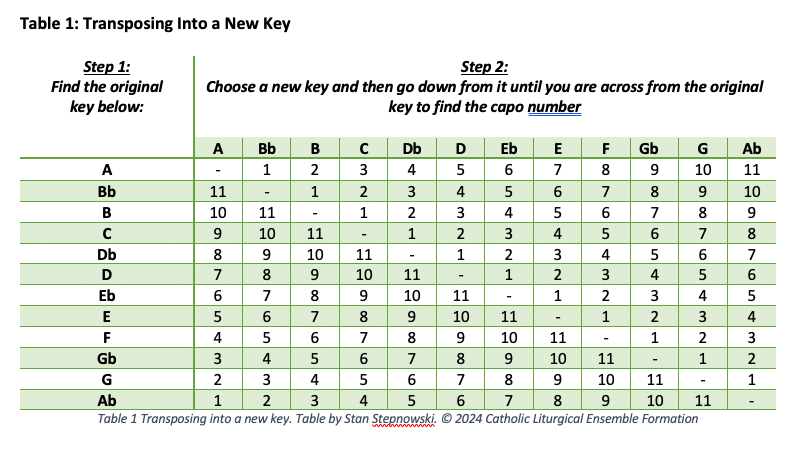
In most cases, capoing up past the seventh fret or so isn’t practical, as the guitar’s neck is wider and thicker up there. Some capos may not work well, and it leaves less room to play. We will cover this situation after talking about the next main use for a capo.
Scenario 2: Keeping the same key but with new chord shapes
There are situations as guitarists where we don’t want to change the key of the song, but we want to use different chord shapes. Songs in keys with several sharps or flats aren’t exactly in guitar-friendly keys because of how the guitar is tuned. It’s not our fault we don’t have a separate string for every note! Another reason to capo and change the chord shapes would be to use a different area of the fretboard to create a different sound that goes well with another guitarist who is not using a capo.
Whatever the reason, the basic concept is simple. To keep the key the same while using a capo, you must transpose the chords down to compensate for the capo moving the key up. For every half step (or fret) the capo raises the pitch of the strings, the chord shapes used must be transposed down a half step.
For this scenario, I’ve created two tables. Table 2 is an abbreviated version of the earlier table because it only includes the most guitar-friendly keys of C, A, G, E, and D. This will help you chose which chord family shapes to use while not capoing at an impossibly high fret. The next table, Table 3, helps you transpose the old chords into the new chord family shapes you’ll need.
Referencing several tables, each with its own purpose, may be easier to use and understand than trying to use a more complicated single table for this purpose.
Let’s try an example with the song “Jesus Christ Is Risen Today.” This is in the key of C, so there’s no need to simplify the chords for the guitar. However, if you want to add variety when playing with another guitarist or be better able to reach the higher notes while playing in a chord melody style, you need to capo the song up while keeping it in C.
See Table 2 below. In Step 1, look down the far-left column until you arrive at the song’s key of C. Then, in Step 2, choose a new guitar-friendly chord family and follow it down until you reach the row for the key of C you landed on in Step 1. I chose G for myself, so I follow from G down until I reach the row for the key of C and land on the number 5. This tells me that I need to capo at the fifth fret.
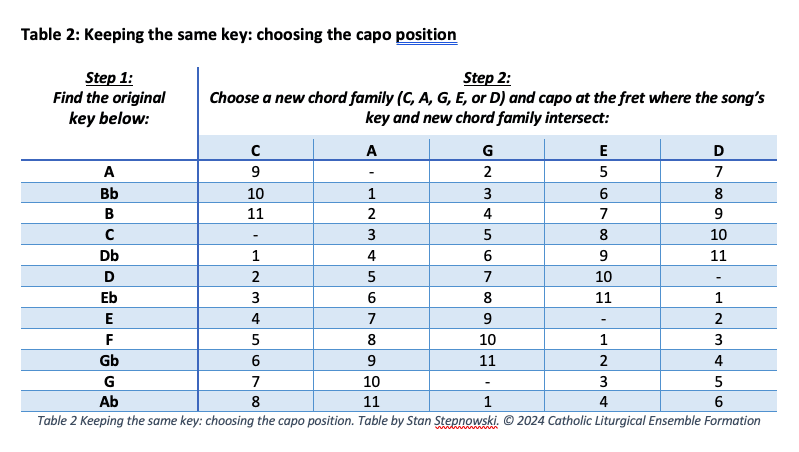
Now that the new chord family of G has been chosen, refer to Table 3. This table lets us transpose each chord of the song into its new name. We’re capoing at the fifth fret, so look at column five for Step 3. When you land on the root note for the chord you want to transpose, stop and go all the way to the right-hand column.
For example, to transpose the C chord in the song, follow column 5 down until you land on C. Follow that straight over right and you’ll see that any C chord will be played as a G. If there’s any modifier to the chord name, like “m7,” just add that afterwards. In this case, any Dm7 chord will be played as an Am7 and a G7 would become a D7, and so on. The bass note in a slash chord follows the table, too — a G/B chord would be played as a D/F# (since Gb and F# are the same note, and the key signature for G would call for the F#).
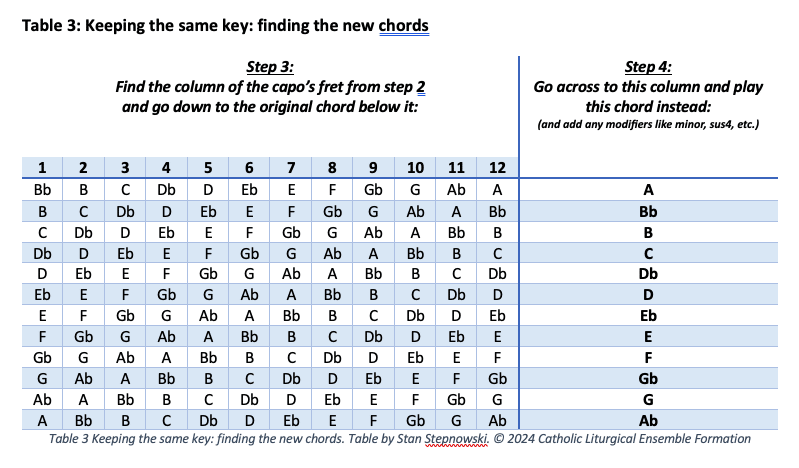
Special cases: When to combine these approaches
Let’s go back to the earlier mention of a scenario where you want to change the song’s key but the capo’s fret position would be impractically high. In this case, we would use a combination of all the above techniques.
For example, imagine a song is in G, but you want to transpose it to the key of F. Table 1 would suggest capoing at the tenth fret. This is unworkable on most acoustic guitars, so let’s come up with another solution.
Refer back to Table 1. Start at Step 1 and go down to G. Now go over right until you get to the F column (where it says 10). Now search the F column until you see a lower, more practical capo fret number that also goes with an easier guitar key like C, A, G, E, or D.
Good choices would be using C shapes and capoing at the fifth fret, or D shapes while capoing at the third fret, or using E shapes while capoing at the first fret.

Now that the chord shape family and capo position have been chosen, use Table 3 to transpose the individual chords of the song. Start with the 12 column and move down to the song’s original key of G. Then move over to the new key of F in the 10 column. Now find the F in the capo position 3 column. Follow that over all the way right to arrive at the new chord to play, D.
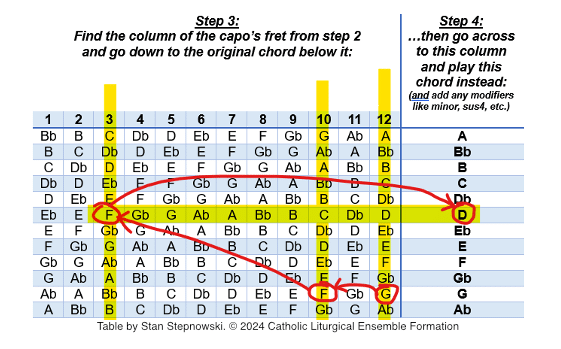
Conclusion
It may look complicated, but if you break it down into the individual steps, it does begin to make sense. If you start using a capo to transpose keys often enough, and do it while paying attention to the patterns, you will get to a point where this will become a comfortable skill and you won’t need the tables anymore.
Even if you’re not transposing a song because the sheet music offers a choice of a capo position, think about that choice, why it makes sense, and what other possibilities could have been chosen, too.
Consider these tables to be tools on your journey of learning the fretboard, and how keys, scales, and chords work together — and how you can make them work for you.
Want a print-friendly version of this article? Download the printable PDF. You may also click on each table image to save or print only the tables for reference.
Written by Stan Stepnowski, a liturgical musician with 30+ years of experience. He is a volunteer guitarist, bassist, and mandolinist at St. John the Evangelist church in Little Canada, Minnesota in the contemporary ensemble alongside his wife and two sons.
Copyright © 2024 by Catholic Liturgical Ensemble Formation
Looking for more resources? Search our full online library of CLEF Life resources, or sign up for CLEF Life email updates to receive the latest resource in your inbox once a week.

